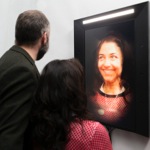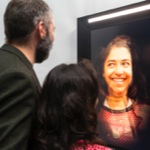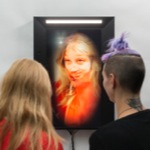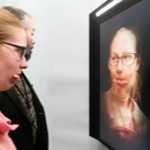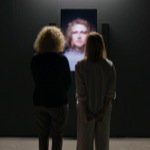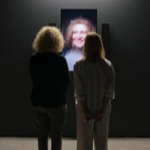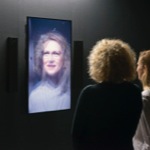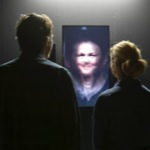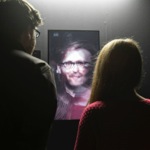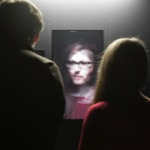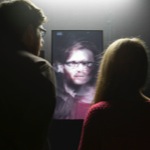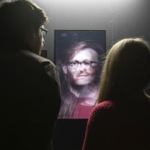Redundant Assembly
In "Redundant Assembly" an arrangement of several cameras composes a live-portrait of the visitor from six perspectives simultaneously, aligned using face detection. The resulting image is uncanny, detached from the laws of symmetry and the depth perception of binocular vision. If several visitors are standing in front of the work, a composite portrait of their different facial features develops in real-time, creating a mongrel "selfie.”
A version of the work for public space includes a time-component that allows the face blending to take place mixing present and the past. Face recognition is a technique often used by police, military, and corporate entities to search for and find suspicious or target people. Here, the same technology is used to confuse portraits and emphasize the artificiality and arbitrariness of identification.
A version of the work for public space includes a time-component that allows the face blending to take place mixing present and the past. Face recognition is a technique often used by police, military, and corporate entities to search for and find suspicious or target people. Here, the same technology is used to confuse portraits and emphasize the artificiality and arbitrariness of identification.
General info
Spanish name:
Ensamblaje Redundante
Year of creation:
2015
Technique:
Computer, HD digital cameras, thunderbolt hub, code written in OpenFrameworks
Power:
800W on 110-220V
Room conditions:
the piece works with natural or artificial light, but the public needs to be well illuminated. The piece does not generate sound
Dimensions:
Display is 75 x 65 x 15 cm, accompanying Mac Pro computer is 17 x 17 x 25 cm
Edition:
6 Editions, 1 AP
Collectors:
21c Museum and private collector
Exhibitions
- Collection Majudia - New Selection of Works, Arsenal Art Contemporain, Montréal, Québec, Canada, 2025 - 2026.
- Truth or Dare: A Reality Show, 21c Museum, Chicago, Illinois, United States, 2025 - 2026.
- The NewArt {collection}, V2_, Rotterdam, Netherlands, 2023.
- Open Codes. We Are Data, Azkuna Zentroa, Bilbao, Spain, 2019 - 2020.
- Relations, Kunstkraftwerk, Leipzig, Germany, 2018 - 2019.
- Seeing Now, 21c Museum, Nashville, Tennessee, United States, 2018 - 2019.
- NGV Triennale, National Gallery of Victoria, Melbourne, Australia, 2017 - 2018.
- 3rd Edition: On Desire, B3 Biennale of the Moving Image, Four Frankfurt, Frankfurt, Germany, 2017.
- Aproximacions Creatives - Collecció BEEP d'Art Electrònic, Museu Salvador Vilaseca, Reus, Spain, 2017 - 2018.
- Sin Título (Untitled), Jonathan Ferrara Gallery, New Orleans, Louisiana, United States, 2017.
- KM3, Quartier des Spectacles, Montréal, Québec, Canada, 2017.
- ARCO '17, BEEP, Madrid, Spain, 2017.
- Rafael Lozano-Hemmer: Preabsence, Haus der elektronischen Künste Basel, Basel, Switzerland, 2016.
- Rafael Lozano-Hemmer: Lapsus Lumen, bitforms gallery, New York City, New York, United States, 2015.
Credits
- Programming: Stephan Schulz
- Hardware: Stephan Schulz
- Production Assistance: Pierre Fournier, Andreas Schmelas
Bibliography
- "Rafael Lozano-Hemmer 'Preabsence' at House of Electronic Arts, Basel." Mousse Magazine, 23 June 2016. Milan, Italy, 2016. (english) (Magazines)
- "Das Haus für elektronische Künste in Münchenstein zeigt Werke von Rafael Lozano-Hemmer." Badische Zeitung, 10 June 2016. Freiburg im Breisgau, Germany, 2016. (deutsch) (Newspapers)
- Bosco, Roberta. "Arco Beep premia a Lugán por su obra radical." El País, 26 Feb. 2017. Madrid, Spain, 2017. (español) (Newspapers)
- Chardon, Elisabeth. "A Bâle, des ouvres qui pulsent au rythme de votre coeur." Le Temps, 8 Aug. 2016. Genève, Switzerland, 2016. (français) (Newspapers)
- Da Silva, Jose, et al.. "Six shows to see during Art Basel." The Art Newspaper, 14 June 2016. London, United Kingdom, 2016. (english) (Newspapers)
- Önol, Isin. "Rafael Lozano-Hemmer ve Kolektif Bellek." Artful Living, 28 July 2016. Istanbul, Turkey, 2016. (türkçe) (Websites)
- Roffiel, Othiana. "Rafael Lozano-Hemmer. Cuando el retrato se convierte en paisaje." Artishock, 21 June 2016. Chile, 2016. (español) (Websites)
Photo Library (click to expand)
